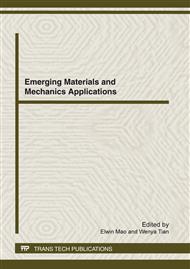[1]
W. Wolf, Cyber-physical Systems, IEEE Computer, Vol. 42, No. 3, 2009: 88 – 89.
Google Scholar
[2]
Inhyok Cha; Shah, Y.; Schmidt, A.U.; Leicher, A.; Meyerstein, M.V., Trust in M2M communication, IEEE Vehicular Technology Magazine, Vol. 4, No. 3, 2009: 69 – 75.
DOI: 10.1109/mvt.2009.933478
Google Scholar
[3]
Atakan, B.; Akan, O.B., Carbon nanotube-based nanoscale ad hoc networks, IEEE Communications Magazine, Vol. 48, No. 3, 2010: 129 – 135.
DOI: 10.1109/mcom.2010.5473874
Google Scholar
[4]
Ibrahim, G.; Plytage, A., UHF RFID Systems Their Susceptibility to Backscattered Signals Induced by Electronic Ballast Driven Fluorescent Lamps, IEEE Transactions on Antennas and Propagation, Vol. 58, No. 7, 2010: 2473 – 2478.
DOI: 10.1109/tap.2010.2048841
Google Scholar
[5]
Sharma, M.; Siddiqui, A., RFID based mobiles: Next generation applications, 2010 IEEE International Conference on Information Management and Engineering (ICIME), 2010: 523 – 526.
DOI: 10.1109/icime.2010.5477641
Google Scholar
[6]
Presser, M.; Barnaghi, P.M.; Eurich, M.; Villalonga, C.; The SENSEI project: integrating the physical world with the digital world of the network of the future, Vol. 47, No. 4, 2009: 1 – 4.
DOI: 10.1109/mcom.2009.4907403
Google Scholar
[7]
Hammoudeh, M.; Mount, S.; Aldabbas, O.; Stanton, M.; Clinic: A Service Oriented Approach for Fault Tolerance in Wireless Sensor Networks, 2010 International Conference on Sensor Technologies and Applications (SENSORCOMM), 2010: 625 – 631.
DOI: 10.1109/sensorcomm.2010.98
Google Scholar
[8]
Kenneally, E.E.; Claffy, K.; Dialing Privacy and Utility: A Proposed Data-Sharing Framework to Advance Internet Research, IEEE Security and Privacy, Vol. 8, No. 4, 2010: 31 – 39.
DOI: 10.1109/msp.2010.57
Google Scholar
[9]
Welbourne, E.; Battle, L.; Cole, G.; Gould, K.; Rector, K.; Raymer, S.; Balazinska, M.; Borriello, G.; Building the Internet of Things Using RFID: The RFID Ecosystem Experience,Vol. 13, No. 3, 2009: 48 – 55.
DOI: 10.1109/mic.2009.52
Google Scholar
[10]
Guangquan Zhang; Zhaoliang Zhang; Jianxi Fan; A Locally-Adjustable Planar Structure for Adaptive Topology Control in Wireless Ad Hoc Networks, IEEE Transactions on Parallel and Distributed Systems, Vol. 21, No. 10, 2010: 1387 – 1397.
DOI: 10.1109/tpds.2009.170
Google Scholar


